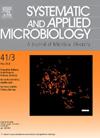Pseudomonas petrae sp. nov. isolated from regolith samples in Antarctica.
IF 3.3
2区 生物学
Q2 BIOTECHNOLOGY & APPLIED MICROBIOLOGY
引用次数: 0
Abstract
A polyphasic taxonomic approach was used to characterize the four strains P2653T, P2652, P2498, and P2647, isolated from Antarctic regolith samples. Initial genotype screening performed by PCR fingerprinting based on repetitive sequences showed that the isolates studied formed a coherent cluster separated from the other Pseudomonas species. Identification results based on 16S rRNA gene sequences showed the highest sequence similarity with Pseudomonas graminis (99.7%), which was confirmed by multilocus sequence analysis using the rpoB, rpoD, and gyrB genes. Genome sequence comparison of P2653T with the most related P. graminis type strain DSM 11363T revealed an average nucleotide identity of 92.1% and a digital DNA-DNA hybridization value of 46.6%. The major fatty acids for all Antarctic strains were C16:0, Summed Feature 3 (C16:1ω7c/C16:1ω6c) and Summed Feature 8 (C18:1ω7c/C18:1ω6c). The predominant respiratory quinone was Q-9, and the major polar lipids were phosphatidylethanolamine, diphosphatidylglycerol, and phosphatidylglycerol. The regolith strains could be differentiated from related species by the absence of arginine dihydrolase, ornithine and lysine decarboxylase and by negative tyrosine hydrolysis. The results of this polyphasic study allowed the genotypic and phenotypic differentiation of four analysed strains from the closest related species, which confirmed that the strains represent a novel species within the genus Pseudomonas, for which the name Pseudomonas petrae sp. nov. is proposed with P2653T (CCM 8850T = DSM 112068T = LMG 30619T) as the type strain.从南极风化层样品中分离到的假单胞菌属(Pseudomonas petrae sp.nov.)。
采用多相分类学方法对从南极风化层样品中分离的四个菌株P2653T、P2652、P2498和P2647进行了鉴定。通过基于重复序列的PCR指纹图谱进行的初步基因型筛选表明,所研究的分离株形成了与其他假单胞菌物种分离的连贯簇。基于16S rRNA基因序列的鉴定结果显示与禾谷假单胞菌的序列相似性最高(99.7%),这通过使用rpoB、rpoD和gyrB基因的多点序列分析得到证实。P2653T与最相关的P.graminis型菌株DSM 11363T的基因组序列比较显示,平均核苷酸同一性为92.1%,数字DNA-DNA杂交值为46.6%。所有南极菌株的主要脂肪酸为C16:0、加总特征3(C16:1ω7c/C16:1ω6c)和加总特征8(C18:1ω7c/C18:1Ω6c)。主要的呼吸醌是Q-9,主要的极性脂质是磷脂酰乙醇胺、二磷脂酰甘油和磷脂酰甘油。风化层菌株可以通过不存在精氨酸二氢酶、鸟氨酸和赖氨酸脱羧酶以及通过负酪氨酸水解与相关物种区分。这项多相研究的结果允许四个分析菌株从最接近的亲缘物种中进行基因型和表型分化,这证实了这些菌株代表了假单胞菌属中的一个新物种,因此提出了名称Pseudomonas petrae sp.nov.,P2653T(CCM 8850T=DSM 112068T=LMG 30619T)作为模式菌株。
本文章由计算机程序翻译,如有差异,请以英文原文为准。
求助全文
约1分钟内获得全文
求助全文
来源期刊

Systematic and applied microbiology
生物-生物工程与应用微生物
CiteScore
7.50
自引率
5.90%
发文量
57
审稿时长
22 days
期刊介绍:
Systematic and Applied Microbiology deals with various aspects of microbial diversity and systematics of prokaryotes. It focuses on Bacteria and Archaea; eukaryotic microorganisms will only be considered in rare cases. The journal perceives a broad understanding of microbial diversity and encourages the submission of manuscripts from the following branches of microbiology:
 求助内容:
求助内容: 应助结果提醒方式:
应助结果提醒方式:


